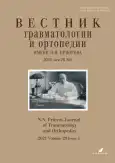Surgical treatment of Jeune syndrome in a child (rare clinical case and review)
- Authors: Komolkin I.A.1,2, Mushkin A.Y.1, Agranovich O.E.3, Afanasiev A.P.4
-
Affiliations:
- St. Petersburg State Research Institute of Phthisiopulmonology
- St. Petersburg State Pediatric Medical University
- H. Turner National Medical Research Center for Сhildren’s Orthopedics and Trauma Surgery
- N.N. Priorov National Medical Research Center of Traumatology and Orthopedics
- Issue: Vol 28, No 1 (2021)
- Pages: 45-52
- Section: Articles
- URL: https://journals.rcsi.science/0869-8678/article/view/42334
- DOI: https://doi.org/10.17816/vto42334
- ID: 42334
Cite item
Full Text
Abstract
Objective: possibility of surgical treatment of chest deformity in children with Jeune syndrome (analysis of the clinical case), review of literature on Jeune syndrome in children.
Methods: clinical, radiological, laboratory, instrumental, statistical.
Results: Positive outcome of surgical treatment of a 3-year-old patient with severe chest deformity and severe respiratory failure.
Conclusions: Jeune syndrome is a severe disease with a high mortality rate. A multidisciplinary approach is required in the treatment of patients with this pathology. Surgical intervention aimed at reducing the compression of the chest organs and increasing its volume, even in conditions of decompensation, allows you to stop the phenomenon of respiratory failure.
Full Text
##article.viewOnOriginalSite##About the authors
Igor A. Komolkin
St. Petersburg State Research Institute of Phthisiopulmonology; St. Petersburg State Pediatric Medical University
Email: igor_komolkin@mail.ru
ORCID iD: 0000-0002-0021-9008
MD, PhD, Dr. Sci. (Med.)
Russian Federation, Saint Petersburg; Saint PetersburgAleksandr Yu. Mushkin
St. Petersburg State Research Institute of Phthisiopulmonology
Email: aymushkin@mail.ru
ORCID iD: 0000-0002-1342-3278
MD, PhD, Dr. Sci. (Med.), Professor
Russian Federation, Saint PetersburgOlga E. Agranovich
H. Turner National Medical Research Center for Сhildren’s Orthopedics and Trauma Surgery
Email: olga_agranovich@yahoo.com
ORCID iD: 0000-0002-6655-4108
MD, PhD, Dr. Sci. (Med.)
Russian Federation, Pushkin, Saint PetersburgArdan P. Afanasiev
N.N. Priorov National Medical Research Center of Traumatology and Orthopedics
Author for correspondence.
Email: afanasevap@cito-priorov.ru
ORCID iD: 0000-0002-5089-2524
MD, PhD, Cand. Sci. (Med.)
Russian Federation, 10 Priorova str., Moscow, 127299References
- Jeune M, Béraud C, Carron R. Asphyxiating thoracic dystrophy with familial characteristics. Arch Fr Pediatr. 1955;12(8):886–891. (In French)
- Barnes ND, Hull D, Symons JS. Thoracic dystrophy. Arch Dis Child. 1969;44(233):11–17. doi: 10.1136/adc.44.233.11
- Todd DW, Tinguely SJ, Norberg WJ. A thoracic expansion technique for Jeune’s asphyxiating thoracic dystrophy. J Pediatr Surg. 1986;21(2):161–163. doi: 10.1016/s0022-3468(86)80073-2
- Davis JT, Long FR, Adler BH, et al. Lateral thoracic expansion for Jeune syndrome: evidence of rib healing and new bone formation. Ann Thorac Surg. 2004;77(2):445–448. doi: 10.1016/S0003-4975(03)01340-7
- Muthialu N, Mussa S, Owens CM, et al. One-stage sequential bilateral thoracic expansion for asphyxiating thoracic dystrophy (Jeune syndrome). Eur J Cardiothorac Surg. 2014;46(4):643–647. doi: 10.1093/ejcts/ezu074
- Mayer O, Campbell R, Cahill P, Redding G. Thoracic insufficiency syndrome. Curr Probl Pediatr Adolesc Health Care. 2016;46(3):72–97. doi: 10.1016/j.cppeds.2015.11.001
- Komolkin IA, Mushkin AYu, Ulrich EV. Congenital malformations of the chest: 3D model, classification and quantification (new approach to tactical systematization of pathology). Meditsinskii al’yans. 2019;7(3):57–65. (In Russ.) doi: 10.36422/2307-6348-2019-7-3-57-65
- Oberklaid F, Danks DM, Mayne V, Campbell P. Asphyxiating thoracic dysplasia. Clinical, radiological, and pathological information on 10 patients. Arch Dis Child. 1977;52(10):758–765. doi: 10.1136/adc.52.10.758
- Keppler-Noreuil KM, Adam MP, Welch J, et al. Clinical insights gained from eight new cases and review of reported cases with Jeune syndrome (asphyxiating thoracic dystrophy). Am J Med Genet A. 2011;155A(5):1021–1032. doi: 10.1002/ajmg.a.33892
- Shaheen R, Schmidts M, Faqeih E, et al. A founder CEP120 mutation in Jeune asphyxiating thoracic dystrophy expands the role of centriolar proteins in skeletal ciliopathies. Hum Mol Genet. 2015;24(5):1410–1419. doi: 10.1093/hmg/ddu555
- Ovsyannikov DY, Stepanova EV, Belyashova MA, Degtyareva EA. Jeune syndrome: case series report. Annals of the Russian Academy of Medical Sciences. 2016;71(1):61–67. (In Russ.) doi: 10.15690/vramn634
- de Vries J, Yntema JL, van Die CE, et al. Jeune syndrome: description of 13 cases and a proposal for follow-up protocol. Eur J Pediatr. 2010;169(1):77–88. doi: 10.1007/s00431-009-0991-3
- Labrune P, Fabre M, Trioche P, et al. Jeune syndrome and liver disease: report of three cases treated with ursodeoxycholic acid. Am J Med Genet. 1999;87(4):324–328. doi: 10.1002/(sici)1096-8628(19991203)87:4<324::aid-ajmg8>3.0.co;2-u
- Yerian LM, Brady L, Hart J. Hepatic manifestations of Jeune syndrome (asphyxiating thoracic dystrophy). Semin Liver Dis. 2003;23(2):195–200. doi: 10.1055/s-2003-39950
- Tüysüz B, Bariş S, Aksoy F, et al. Clinical variability of asphyxiating thoracic dystrophy (Jeune) syndrome: evaluation and classification of 13 patients. Am J Med Genet A. 2009;149A(8):1727–1733. doi: 10.1002/ajmg.a.32962
- Imai Y, Kitanishi R, Saiki Y, et al. Distraction osteogenesis of the sternum for thoracic expansion in a severe case of Jeune syndrome: a preliminary report. J Plast Surg Hand Surg. 2016;50(3):180–183. doi: 10.3109/2000656X.2016.1147736
Supplementary files










